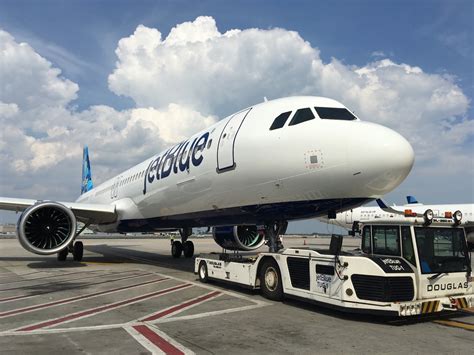
JetBlue is scaling back its flight schedule and cautioning investors about a weaker-than-expected travel market, citing persistent economic uncertainty as a primary factor dampening demand. The airline anticipates lower revenue in the near term as a result.
JetBlue Airways (JBLU) announced plans to reduce its flight capacity in the second half of 2024, signaling concerns about the resilience of travel demand amid ongoing economic headwinds. The New York-based carrier indicated that it expects revenue to decline, prompting the adjustment to its flight schedule as it navigates a more cautious market environment. This decision comes as a surprise to some industry observers who had predicted continued robust travel demand throughout the year.
The airline’s executives pointed to a confluence of factors contributing to the softened demand. These include persistent inflation, which is eroding consumers’ discretionary spending power, and broader macroeconomic uncertainties that are making travelers more hesitant to commit to travel plans. “We’ve seen a softening in demand materialize more recently than we had anticipated,” explained Joanna Geraghty, JetBlue’s Chief Executive Officer. “While leisure demand remains an important part of JetBlue’s revenue mix, its performance has been lackluster lately. We feel it is prudent to be proactive about our capacity in light of the latest demand trends.”
JetBlue’s announcement underscores a potential shift in the travel industry landscape. While travel surged post-pandemic, driven by pent-up demand and a desire for experiences, the current economic climate appears to be tempering that enthusiasm. Other airlines are closely watching JetBlue’s moves, as they could signal a broader trend affecting the entire sector. The company will be implementing capacity cuts in markets where demand is weaker, while trying to bolster performance on its most profitable routes. This strategy involves reallocating resources to more lucrative destinations and optimizing its network to better align with current demand patterns.
Capacity Reduction and Network Adjustments
To address the softening demand, JetBlue plans to decrease its capacity, measured in available seat miles (ASM), by low single digits in the third quarter and by 5% to 10% in the fourth quarter of 2024. The airline aims to optimize its network by reducing flights on underperforming routes and redeploying aircraft to more profitable markets. JetBlue’s network adjustments may affect various domestic and international destinations, depending on demand trends and route profitability. The airline said it will provide more specific details about the routes affected by the capacity cuts in the coming weeks.
“We are taking a disciplined approach to capacity management to mitigate the impact of softer demand,” stated Ursula Hurley, JetBlue’s Chief Financial Officer. “These adjustments will allow us to focus on our core markets and improve our financial performance.” The airline’s strategy emphasizes operational efficiency and cost control, aiming to improve profitability despite the challenging demand environment.
Financial Implications and Outlook
JetBlue’s decision to cut flights and adjust its network will have financial implications in the near term. The airline expects its revenue per available seat mile (RASM) to decline in the coming months. While the exact impact will depend on the effectiveness of the capacity adjustments and the overall demand environment, the airline is taking steps to minimize the financial consequences.
The airline is also focused on managing its costs and improving its operational efficiency to mitigate the impact of lower revenue. JetBlue has been implementing various cost-saving initiatives, including streamlining its operations, renegotiating contracts with suppliers, and optimizing its fleet utilization. These measures are designed to improve the airline’s profitability and financial resilience in the face of economic uncertainty.
JetBlue’s management team emphasized that these are proactive measures to navigate current market conditions, emphasizing that they maintain a positive long-term outlook for the airline and the travel industry. They believe that demand will eventually rebound as economic conditions improve and consumer confidence returns.
Industry Context and Competitive Landscape
JetBlue’s announcement comes at a time when the broader airline industry is facing a mix of challenges and opportunities. While travel demand has generally been strong since the pandemic, rising costs, supply chain disruptions, and economic uncertainty have created headwinds for airlines.
Other airlines have also reported mixed results and cautious outlooks, suggesting that the softening demand is not limited to JetBlue. Several carriers have adjusted their capacity plans and implemented cost-saving measures to navigate the evolving market conditions. The competitive landscape remains intense, with airlines vying for market share and trying to attract price-sensitive travelers.
Expert Analysis and Commentary
Industry analysts have offered various perspectives on JetBlue’s decision and its implications for the airline industry. Some analysts believe that the capacity cuts are a prudent move to align supply with demand and protect profitability. Others express concern about the potential impact on revenue and market share.
“JetBlue is taking a proactive approach to address the softening demand environment,” said Helane Becker, a Cowen analyst. “While the capacity cuts will likely impact revenue in the short term, they should help the airline improve its profitability and financial performance over the long run.”
Another industry expert, Jamie Baker at JP Morgan, noted that “the concerns expressed by JetBlue align with broader data pointing to a recent softening in leisure travel demand. Other airlines will be watching JetBlue’s experience closely to evaluate if similar actions should be considered.”
Consumer Impact and Travel Planning
For consumers, JetBlue’s capacity cuts may mean fewer flight options and potentially higher fares on certain routes. Travelers are advised to book their flights in advance and be flexible with their travel dates to secure the best deals.
JetBlue has stated that it will work to minimize disruptions to passengers’ travel plans and provide alternative options when possible. However, some travelers may experience schedule changes or flight cancellations as a result of the capacity adjustments.
The airline encourages customers to monitor their flight status and contact JetBlue’s customer service team for assistance with any travel-related issues. Travelers who are concerned about potential disruptions should consider purchasing travel insurance to protect themselves against unforeseen circumstances.
JetBlue’s Long-Term Strategy
Despite the near-term challenges, JetBlue remains committed to its long-term growth strategy. The airline is focused on expanding its network, enhancing its customer experience, and improving its operational efficiency. JetBlue is also investing in new technologies and sustainability initiatives to ensure its long-term competitiveness.
JetBlue’s acquisition of Spirit Airlines, which is still under regulatory review, could significantly reshape the competitive landscape of the U.S. airline industry. If approved, the merger would create the fifth-largest airline in the United States and allow JetBlue to expand its network and offer more low-fare options to consumers. However, the merger faces significant regulatory hurdles, and its outcome remains uncertain.
JetBlue’s management team is confident that the airline can navigate the current challenges and emerge stronger in the long run. They believe that the airline’s unique brand, customer-centric culture, and focus on innovation will continue to differentiate it from its competitors.
JetBlue’s Acquisition of Spirit Airlines (Update)
It’s critical to provide the latest updates regarding JetBlue’s planned acquisition of Spirit Airlines. As of the time of the original article, the acquisition was still under regulatory review. Since then, a federal judge blocked JetBlue’s planned acquisition of Spirit Airlines, agreeing with the Justice Department that it would violate antitrust law and drive up prices for consumers. This outcome throws JetBlue’s future strategy into question, especially considering how integral this acquisition was to their expansion plans and competitive positioning against larger airlines.
JetBlue and Spirit have both expressed disappointment in the court’s decision and are evaluating their options, including a potential appeal. However, the likelihood of a successful appeal is uncertain, given the judge’s strong stance on the anti-competitive effects of the merger. This development has significant implications for both airlines, as well as the broader airline industry.
The Future of Low-Cost Carriers
This situation puts a spotlight on the challenges faced by low-cost carriers (LCCs) in an increasingly consolidated industry. Spirit’s struggles and the failed merger with JetBlue highlight the difficulties LCCs face in competing with larger, more established airlines that have significant network advantages and financial resources. The future success of low-cost airlines may depend on their ability to innovate, differentiate themselves from competitors, and adapt to changing market conditions.
Revised Strategies and Future Outlook
Given the current circumstances, JetBlue will need to reassess its strategic priorities and consider alternative paths to growth. This may involve focusing on organic growth, expanding partnerships with other airlines, or exploring new market opportunities. The airline’s management team will need to develop a revised strategy that takes into account the evolving competitive landscape and the challenges facing the airline industry.
Detailed Look at the Numbers
Digging into the numbers behind JetBlue’s announcement offers further insights. The projected low single-digit percentage reduction in capacity (ASM) for Q3 and the 5% to 10% reduction for Q4 translate to a significant number of flights and seats removed from the market. This capacity cut is intended to address the observed decline in RASM. The goal is to ensure each available seat is generating higher revenue, even if the total number of seats is lower.
The financials are directly affected by not only the volume of passengers but the yields obtained per passenger. While fuel costs have stabilized somewhat, labor costs continue to be a significant expense for airlines. JetBlue has actively been in negotiations with its pilot and flight attendant unions to manage these labor costs effectively. Successfully managing these operating expenses while revenue is under pressure is crucial for maintaining profitability.
The Impact on Airports and Local Economies
JetBlue’s capacity cuts will also have ripple effects on airports and local economies, particularly those that rely heavily on JetBlue’s service. Reduced flight frequencies and passenger volumes can impact airport revenues, ground transportation services, and local tourism industries. Communities served by JetBlue may experience a decline in economic activity as a result of the airline’s reduced presence. Airports and local economic development agencies may need to adjust their strategies to mitigate the impact of the capacity cuts and attract new air service.
Analyzing Consumer Behavior Changes
One of the critical factors influencing JetBlue’s decisions is the shift in consumer behavior since the peak of the post-pandemic travel boom. The initial surge was fueled by pent-up demand, and many travelers were willing to pay higher prices for flights and accommodations. Now, with macroeconomic pressures such as inflation and high interest rates, consumers are becoming more price-sensitive and discerning about their travel spending.
Many travelers are postponing or scaling back their travel plans, opting for shorter trips, closer destinations, or alternative modes of transportation. The demand for premium travel products, such as first-class and business-class seats, may also be affected as consumers look for ways to save money. These behavioral changes are forcing airlines to adjust their pricing strategies, capacity plans, and marketing efforts to attract and retain customers.
The Role of Loyalty Programs
Airlines’ loyalty programs are becoming increasingly important in attracting and retaining customers in a competitive market. JetBlue’s TrueBlue program offers various benefits to frequent flyers, such as free flights, priority boarding, and waived fees. Enhancing the value and attractiveness of loyalty programs can help airlines build customer loyalty and generate repeat business. Airlines are also exploring new ways to personalize the loyalty experience and offer customized rewards based on individual customer preferences.
Examining the Effects of Business Travel
While leisure travel demand has shown signs of softening, business travel is also facing challenges. Many companies have adopted remote work policies and are reducing their travel budgets to save money. The shift to virtual meetings and conferences has also impacted the demand for business travel. Airlines are trying to attract business travelers by offering flexible booking options, enhanced in-flight amenities, and corporate travel programs. However, the long-term outlook for business travel remains uncertain, and airlines may need to adjust their strategies to adapt to the changing needs of corporate customers.
Sustainability Initiatives
Environmental concerns are increasingly influencing consumer travel decisions, and airlines are under pressure to reduce their carbon emissions and adopt more sustainable practices. JetBlue has invested in fuel-efficient aircraft, sustainable aviation fuels, and carbon offset programs to reduce its environmental impact. Consumers are becoming more aware of the environmental consequences of air travel and are seeking out airlines that are committed to sustainability. Airlines that can demonstrate a genuine commitment to environmental responsibility may gain a competitive advantage in the market.
Impact of Oil Prices
Fluctuations in oil prices are a constant challenge for airlines. Higher fuel costs can significantly impact airlines’ profitability, forcing them to raise fares, cut capacity, or implement cost-saving measures. Airlines hedge their fuel purchases to mitigate the impact of price volatility, but hedging strategies are not always effective. Geopolitical events, supply disruptions, and changes in global demand can all affect oil prices and, consequently, airline profitability. The ability to manage fuel costs effectively is a critical factor in airlines’ financial performance.
The Future of Airline Mergers and Acquisitions
The blocked merger between JetBlue and Spirit Airlines has raised questions about the future of airline mergers and acquisitions. Regulatory agencies are scrutinizing airline mergers more closely, concerned about the potential for increased consolidation, higher fares, and reduced competition. The Justice Department’s opposition to the JetBlue-Spirit merger signals a tougher stance on airline consolidation, which could make it more difficult for airlines to pursue mergers and acquisitions in the future.
FAQ Section:
1. Why is JetBlue cutting flights?
JetBlue is reducing its flight capacity due to a softening in travel demand, primarily driven by economic uncertainty and persistent inflation that is affecting consumer spending habits. According to JetBlue CEO Joanna Geraghty, “We’ve seen a softening in demand materialize more recently than we had anticipated.”
2. How much will JetBlue reduce its flight capacity?
The airline plans to decrease its capacity, measured in available seat miles (ASM), by low single digits in the third quarter and by 5% to 10% in the fourth quarter of 2024.
3. What does this mean for travelers who have already booked flights?
JetBlue has stated that it will work to minimize disruptions to passengers’ travel plans and provide alternative options when possible. However, travelers may experience schedule changes or flight cancellations. The airline encourages customers to monitor their flight status and contact JetBlue’s customer service team for assistance.
4. Will this impact the price of JetBlue flights?
Potentially, yes. Capacity cuts may lead to fewer flight options and potentially higher fares on certain routes, especially during peak travel times.
5. What is the current status of JetBlue’s acquisition of Spirit Airlines?
A federal judge blocked JetBlue’s planned acquisition of Spirit Airlines, agreeing with the Justice Department that it would violate antitrust law and drive up prices for consumers. Both airlines are evaluating their options, including a potential appeal.









